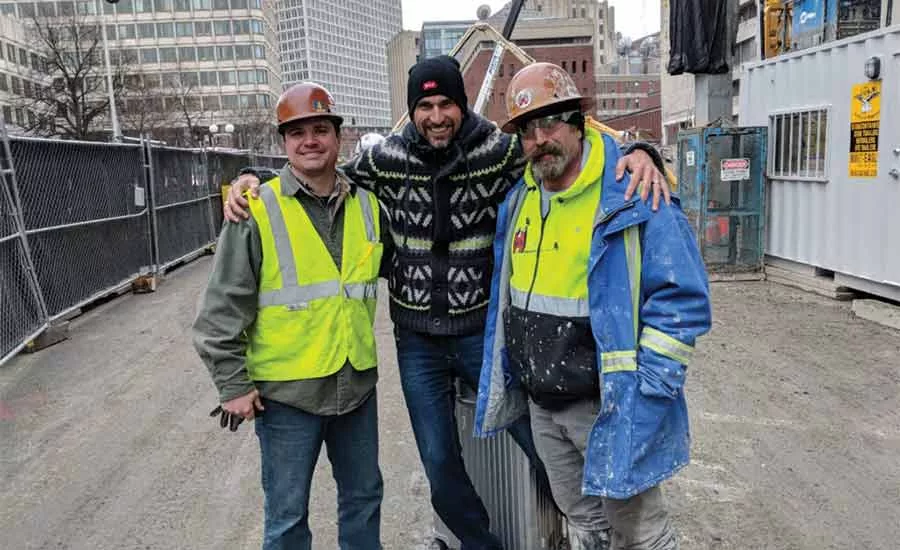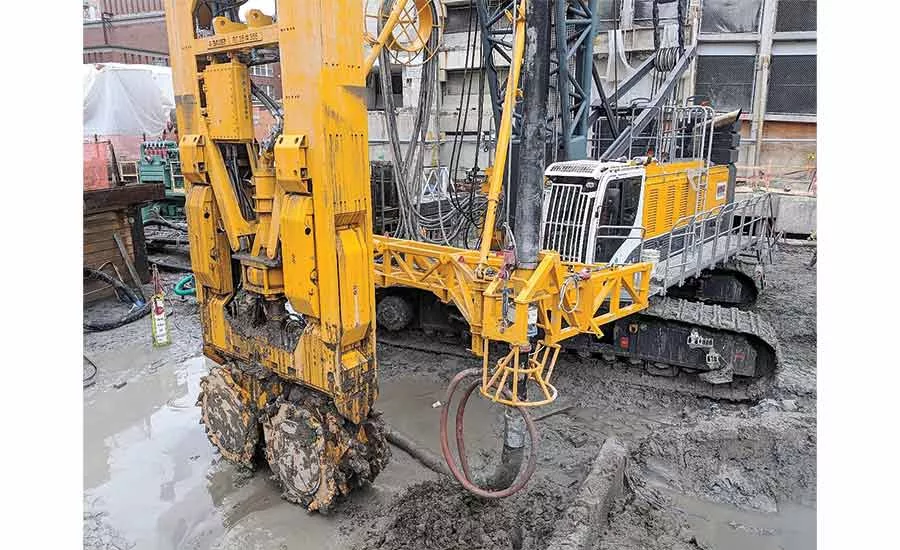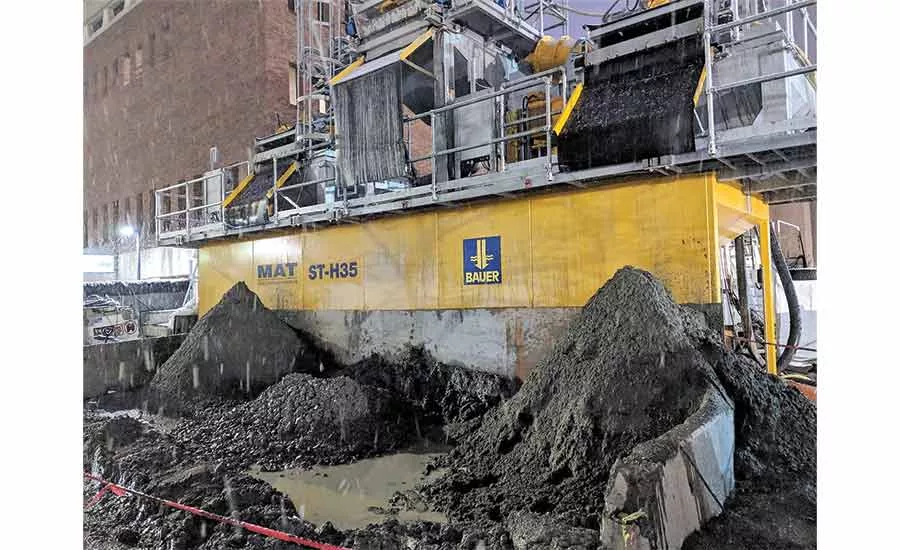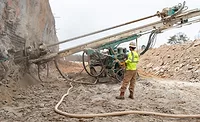With Boston Job, Foundation Firm Adds Slurry Wall Services

Hub Foundation brought in a Bauer MC 96 Duty-Cycle Crane with a BC 35 Trench Cutter to install load bearing elements for the Bullfinch Crossing high-rise project in Boston.
Source: Equipment Corp. of America photos


The MC 96’s HTS (Hose Tensioning System) 58M enabled a cutting depth of up to 190.3 feet.

Hub Foundation Company used a Bauer MC 96 Duty-Cycle Crane with a BC 35 Trench Cutter and a Bauer MAT DE 500-20 Slurry Handling System to put in the foundations for a residential tower at Bullfinch Crossing in Boston. It represents the contractor’s entrance into the slurry wall market and the first time Equipment Corporation of America (ECA) has sold this package of machinery in North America.
A Bold Investment
ECA and Hub already had an established relationship, but it was March 2017 at Con-Expo/Con/Agg when the conversation started about breaking into Boston’s slurry wall market. President and owner Jim Maxwell knew that specialty equipment would be required and would come at a great cost.
Hub had built a reputation as a top-notch drilled-shaft contractor. Although the contractor had developed expertise in bentonite slurry over the years, its leadership team had endless debates about whether to enter the slurry wall market. Bullfinch Crossing, a project Hub had under agreement, presented a timely opportunity that would make the decision clear. The geotechnical engineers had changed course. What started as a drilled-shaft project would now include a slurry wall with load bearing elements (LBEs).
There were no gut decisions; the contractor vetted every major brand of slurry handling equipment before making an investment. Traditionally a loyal Soilmec customer, Hub had assembled an armada of its drilling rigs. The contractor ultimately concluded that Bauer was the right choice for its slurry handling equipment.
Financing an investment of this magnitude was important. Bauer-Pileco’s equipment finance specialist Anja Frazier entered the equation early on to make the numbers work. She prides herself on frequently being able to obtain creative financing, which played a key role in the decision.
“We were able to keep the upfront costs at a minimum by including freight costs and sales tax into the financing,” Frazier explains. “And with a longer financing term, Hub benefits from lower monthly payments, which allows them to be more competitive in bidding jobs.”
Anthony Sciortino, sales engineer for ECA Boston, and his father, David, ultimately closed the deal along with Gordian Ulrich of ECA’s Philadelphia office. Ulrich serves as Bauer applications engineering manager.
“This is unique because you only have a handful of customers that have made the investment to do this type of work,” explains Sciortino. “You can count them on one hand.”
“If you look at the numbers, the investment doesn’t make sense,” admits General Superintendent Greg Maxwell. “You’re talking about upwards of $6 million invested on a job (Bullfinch Crossing) that is less than the entire cost, and you have two competitors in town fighting over the work already.”
Bullfinch Crossing, which would represent Hub’s maiden voyage, was scheduled to begin in August 2017. Hub pushed ECA and Bauer to make sure the equipment would be on site in time, and they delivered. Ironically, the owner then delayed the project until December.
Nevertheless, the equipment was delivered as promised in July. ECA and Bauer took advantage of the extra time by setting up, conditioning and testing the equipment in Hub’s Chelmsford, Mass., yard.
Hub had already closed the deal on the Bauer equipment, but traveled overseas to maximize the investment before firing it up. “Any contractor can buy the equipment, but in order to make money with it, you’ve got to know what you’re doing,” Maxwell explains. “What we were trying to do was get a few rungs up that learning curve before we started doing it ourselves.”
ECA and Bauer funded a trip to Europe so Hub could see the equipment in action and learn from contractors that were using it. The plan was to visit projects in Paris and Germany, in addition to attending Bauer’s Open House in Schrobenhausen, Germany. A chance encounter with Israeli geotechnical contractors Shikun & Binui and Geo Danya of Israel led to a follow-up trip to Tel Aviv where Hub toured multiple projects and received a crash course in slurry wall construction. Ofer Mastbaum of Bauer Maschinen played a key role as well.
Putting the Equipment to Work
Hub was onsite from December 2017 through May 2018, although the slurry wall work took place from February through April. Hub was to install a 36-inch slurry wall and LBEs down to 75 feet to support the 45-story residential tower at Bullfinch Crossing, which is advertised as “the tallest for-rent residential building in the city of Boston.”
The collection of massive Bauer machinery may look out of place in some American cities, but not in Boston. New York and Toronto design their excavation pits for secant pile walls, but Boston’s geotechnical engineers prefer slurry walls. Slurry is effective for holding open excavations in these materials, which is why subsurface conditions in Boston are more conducive to slurry walls than sandier areas like Connecticut or Rhode Island.
Situated in a historic district, the tower is expected to give future residents panoramic views of one of America’s oldest cities. The situation for Hub at the ground level, however, was far from ideal.
The city’s complicated subsurface conditions played a role. Boston was originally an 800-acre peninsula (sometimes called the Shawmut Peninsula). Today, a large portion sits on man-made land due to a series of projects starting in 1630. The soil is a Boston blue clay underlain by glacial till and the Cambridge Argillite. The Cambridge Formation underlies most of the downtown area.
“Because this is ECA’s first endeavor with a Bauer cutter, we hired Bauer Maschinen Technician Daniel Bögl to be on standby for the entire duration of the job,” says Sciortino. “If there was a problem, we could get him up there quickly without having to fly him over from Germany.”
Hub used the Bauer MC 96 with a BC 35 cutter to dig out a rectangular trench for the slurry wall. It also installed LBEs to support the load of the tower. There were 22 70- to 84-foot panels, eight of which interlocked to form the core wall. Each was 3-foot-wide and 9.2- to 22.7-feet long. The job also included 107 85- to 130-foot minipiles and three 85-foot-long, 4-foot-diameter drilled shafts, and 42 piles for support of excavation (SOE).
The excavation was shallower than anticipated, and due to the Boston blue clay, Hub started the excavation using another crane with a grab. The BC 35 was used to clean out the holes and finish the rock sockets, which ranged in length from 17 to 33 feet.
“We felt very confident that the material was going to cooperate as far as the excavation process was concerned,” Maxwell says. “The conditions were almost perfect as far as mitigating risk with a slurry wall.” Hub found that the clay was stiff, the argillite had minimal fractures, the glacial till had cohesive properties, and there were no large areas of sand or gravel in danger of collapsing.
Small Footprint, Big Challenges
The rectangular Bullfinch Crossing site is wedged between the towering walls of the existing Government Center Garage and two busy streets. “It was kind of like a structured ballet,” Maxwell says, referring to moving equipment and materials around on the jobsite. “The key to this job was all logistics.”
The Bauer MC 96 was one of four cranes on site, in addition to a host of drilling and excavating equipment. Hub was restricted from accessing the core wall until late in the project, which hampered its efficiency and sequencing by confining crews to a small portion of the site. Hub chopped away at the slurry wall and LBEs one section at a time and shuttled machinery between working areas and parking spots.
The Bullfinch Crossing project was initially designed to include a combination of drilled shafts and micropiles, but geotechnical engineers Haley and Aldrich added LBEs to the mix.
The challenges of supporting a 45-story building on a small footprint became clear during the core design, according to Maxwell. He explained that these dimensions created tremendous shear load and uplift. The loads on a tower with a larger footprint would have been axial, transferring downward through the foundation.
“Once they (engineers) got into the weeds of the core design they had a lot of difficulty getting those shear loads down into the shaft from the core wall,” Maxwell recalls. “They had a lot more success pushing the loads into the slurry wall that we used because it was basically the same footprint as the shear wall.”
The Equipment
The centerpiece of the operation was a Bauer MC 96 Duty-Cycle Crane. Its HTS (Hose Tensioning System) 58M enabled a cutting depth of up to 190.3 feet. The BC 35 — a 41.3-foot-high-by-9.2-foot-long unit with four cutter wheels — carved out the 36-inch-wide trench for the slurry wall.
“Bauer is known not only for its power and its ability to cut and churn rock quickly, but also its reliability,” says Sciortino. “When you’re on a high production slurry wall job, the reliability of the power comes into play.”
The slurry handling system was a Bauer MAT DE 500, which consists of two BE 250-60 Desilters and an ST H35 Agitation Tank. It was used to remove soil particles from the bentonite slurry used during installation of the LBEs.
Mobilizing the equipment and keeping it running properly was critical. The project delay exacerbated matters. ECA facilitated a connection up front that resulted in Hub hiring industry expert Sal Arslan full-time to keep the Bullfinch Crossing project running smoothly. He helped to set up the slurry handling system, mobilize the crane and cutter, train Hub’s operators, and share his knowledge of slurry wall construction.
Hub acquired the Bauer crane, cutter and slurry handling system as a package, although it could have mixed and matched other brands. By doing so, the contractor was able to use the B-Tronic System, which collects data from dozens of sensors located at all critical points in the cutter. The display of the cutter’s current position and the deviations in both x and y direction enabled the machine operator to adjust the steering plates and maximize performance.
Dealing with Slurry
Hub pumped bentonite from a hose within the cutter to support excavation for the slurry wall. The slurry spoils were then pumped into the Bauer Desanding Plant to remove soil particles. The clean slurry was pumped back into the trench for temporary excavation support.
Project delays put Hub on-site during the winter months. Keeping the plant warm and slurry from freezing was a factor during repeated bouts of snowfall, sleet and freezing rain.
Dealing with the slurry left over from the cutting operation was difficult on the compact site as well. The loadout area for the spoils and the rebar laydown area were one and the same.
“We trucked in as many cages as we could,” Maxwell recalls. “We were able to build the cages for the LBEs offsite, truck them in as needed and put them in the hole right away,” he explains, noting that this kept the slurry loadout area open.
That strategy ended when it was time to build the core wall. They were too big to haul, so Hub’s crews had to assemble them onsite. This resulted in periods of up to four days where slurry spoils were piling up, consuming nearly one-third of the site. Further complicating matters, the landfill only accepted two loads per day and wouldn’t take material during inclement weather.
Solid Foundation for Future Work
Bullfinch Crossing was a successful maiden voyage for Hub. There were no equipment breakdowns and no major surprises underground. More importantly, Hub now has a successful slurry wall project under its belt.
“The clients will have more confidence in our ability to perform contracts,” says Maxwell, noting that Hub was recently awarded another contract in downtown Boston. “We now have the experience, equipment and people to do the work.”
The company plans to concentrate on the New England and upstate New York market for now. Whether Hub’s venture into the slurry wall market pans out remains to be seen.
“It was a bit of a gutsy move,” admits Maxwell. “One of the benefits is that we have a healthy minipile and drilled shaft market that has helped support the debt of this new venture.”
Looking for a reprint of this article?
From high-res PDFs to custom plaques, order your copy today!




